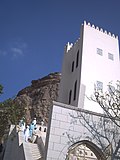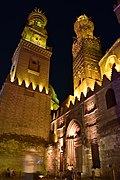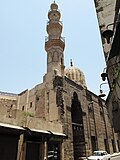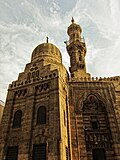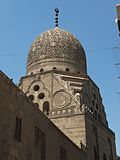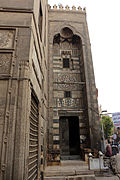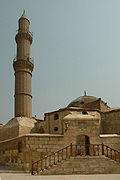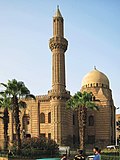Name Image Year (CE ) Period Neighborhood Notes Amr ibn al-As Mosque 642 Rashidun Fustat 30°0′37″N 31°13′59″E / 30.01028°N 31.23306°E / 30.01028; 31.23306 The oldest mosque in Africa; although the building has been rebuilt and modified many times after its foundation. [ 2] [ 3] Mosque of Ibn Tulun 884 Abbasid Sayeda Zainab 30°01′44″N 31°14′58″E / 30.02889°N 31.24944°E / 30.02889; 31.24944 The oldest mosque in the city surviving in its original form, and the largest mosque in Cairo in terms of land area. [ 4] Al-Azhar Mosque 969 Fatimid El-Hussein 30°02′45″N 31°15′46″E / 30.0457°N 31.2627°E / 30.0457; 31.2627 National mosque [ 5] Jami al-Qarafa Mosque 976 Fatimid Al-Qarafa Founded by Al-Sayyida al-Mu'iziyya and her daughter, Sitt al-Malik [ 6] Al-Hakim Mosque 1013 Fatimid Al-Mu'izz Street 30°03′16″N 31°15′50″E / 30.05444°N 31.26389°E / 30.05444; 31.26389 Named in honour of al-Ḥākim bi-Amr Allāh [ 7] [ 8] Lulua Mosque c. 1015 Fatimid Muqattam Hills 30°01′11″N 31°16′05″E / 30.01986°N 31.268187°E / 30.01986; 31.268187 Exact date of establishment is disputed; [ 9] [ 10] extensively rebuilt in 1998. Juyushi Mosque 1085 Fatimid Muqattam Hills 30°01′19″N 31°16′07″E / 30.021992°N 31.2685°E / 30.021992; 31.2685 Described as a mashhad [ 1] : 163–164 Aqmar Mosque c. 1126 Fatimid Al-Mu'izz Street 30°03′06″N 31°15′43″E / 30.051667°N 31.261944°E / 30.051667; 31.261944 An important monument of Fatimid architecture and of historic Cairo due to the exceptional decoration of its exterior façade and the innovative design of its floor plan. [ 11] Mashhad of Sayyida Ruqayya 1133 Fatimid al-Khalifa 30°01′32″N 31°15′7″E / 30.02556°N 31.25194°E / 30.02556; 31.25194 One of the few and most important Fatimid -era preserved mausoleums in Cairo [ 12] Al-Hussein Mosque 1154 Fatimid El-Hussein 30°2′52″N 31°15′47″E / 30.04778°N 31.26306°E / 30.04778; 31.26306 One of the holiest Islamic sites in Egypt, with an eclectic mix of architectural styles. [ 13] Al-Salih Tala'i Mosque 1160 Fatimid Al-Darb al-Ahmar 30°02′32″N 31°15′28″E / 30.04222°N 31.25778°E / 30.04222; 31.25778 Named in honour of Tala'i ibn Ruzzik , and is the last major Fatimid monument to have been built and survived. [ 1] : 124–126 [ 14] Mosque of al-Zahir Baybars 1269 Mamluk al-Husayniya 30°03′44″N 31°15′48″E / 30.0623°N 31.2634°E / 30.0623; 31.2634 Named in honour of al-Zahir Baybars al-Bunduqdari [ 15] Qalawun Mosque 1285 Mamluk Al-Mu'izz Street Bayn al-Qasrayn ) 30°02′58″N 31°15′39″E / 30.049528°N 31.260972°E / 30.049528; 31.260972 An expanisive religious complex that includes a bimaristan (hospital), madrasa, mausoleum, and mosque, built by and named in honour of Sultan al-Mansur Qalawun [ 1] : 219–224 [ 16] Madrasa of al-Nasir Muhammad 1303 Mamluk Al-Mu'izz Street Bayn al-Qasrayn ) 30°02′59″N 31°15′40″E / 30.0497504112967°N 31.26106369365175°E / 30.0497504112967; 31.26106369365175 A madrasa and mausoleum named in honour of al-Nasir Muhammad ibn Qalawu [ 1] : 225–226 Khanqah of Baybars (II) al-Jashankir 1310 Mamluk al-Gamaliyya 30°03′6″N 31°15′50″E / 30.05167°N 31.26389°E / 30.05167; 31.26389 It is the oldest khanqah , or convent , that has survived in modern Cairo; named in honour of Baybars II [ 17] Al-Nasir Muhammad Mosque 1318 Mamluk Cairo Citadel 30°01′45″N 31°15′39″E / 30.029151°N 31.260945°E / 30.029151; 31.260945 Named in honour of Al-Nasr Muhammad [ 18] [ 19] Madrasa of Amir Sunqur Sa'di 1321 Mamluk Al-Darb al-Ahmar 30°01′59″N 31°15′14″E / 30.033122257797206°N 31.253911689287595°E / 30.033122257797206; 31.253911689287595 Established as a madrasa and mausoleum, later repurposed as a Mevlevi Sufi takiyya , and in the 20th century, as an Islamic museum [ 1] : 134–135 [ 20] Mosque of Amir al-Maridani 1339 Mamluk Al-Darb al-Ahmar 30°02′10″N 31°15′36″E / 30.036°N 31.260°E / 30.036; 31.260 Built by Amir Altinbugha al-Maridani, with significant help from Sultan al-Nasir Muhammad [ 21] Aqsunqur Mosque 1347 Mamluk Al-Darb al-Ahmar 30°02′10″N 31°15′36″E / 30.036°N 31.260°E / 30.036; 31.260 Built by Shams ad-Din Aqsunqur and named in his honour; the site contains the mausoleum of Aqsunqur and his sons [ 11] Shaykhu Mosque and Khanqah 1349 Mamluk Al-Saleeba Street 30°01′50″N 31°15′11″E / 30.030511°N 31.252956°E / 30.030511; 31.252956 A mosque and khanqah , completed in 1349 and 1355 respectively, founded by Sayf al-Din Shaykhu al-Nasiri , a Grand Emir. [ 16] [ 22] Mosque of Amir al-Sayf Sarghatmish 1356 Mamluk Al-Saleeba Street 30°01′49″N 31°15′05″E / 30.030385°N 31.251284°E / 30.030385; 31.251284 A madrasa, mosque, and mausoleum founded by Sayf al-Din Sarghatmish al-Nasiri . [ 16] [ 23] Mosque-Madrasa of Sultan Hasan 1362 Mamluk Salah al-Din Square 30°01′57″N 31°15′25″E / 30.032495612245665°N 31.257015464682603°E / 30.032495612245665; 31.257015464682603 Also known as the Mosque of Sultan Hassan [ 4] : 125–129 Madrasa of Umm al-Sultan Sha'ban 1369 Mamluk Al-Darb al-Ahmar 30°02′14″N 31°15′34″E / 30.03722°N 31.25944°E / 30.03722; 31.25944 Built by Sultan al-Ashraf Sha'ban in honour of his mother, Khawand Baraka [ 1] Mosque-Madrasa of Sultan Barquq 1386 Mamluk Al-Mu'izz Street Bayn al-Qasrayn ) 30°03′1″N 31°15′41″E / 30.05028°N 31.26139°E / 30.05028; 31.26139 Founded by Sultan al-Zahir Barquq and comprises a mosque, madrasa, mausoleum, and khanqah [ 24] [ 25] Mahmud al-Kurdi Mosque 1395 Mamluk Al-Darb al-Ahmar 30°02′28″N 31°15′27″E / 30.04111°N 31.25750°E / 30.04111; 31.25750 Founded by Mahmud al-Kurdi [ 1] Amir Jamal al-Din al-Ustadar Mosque 1407 Mamluk Al-Tambakshiya Street 30°03′03″N 31°15′48″E / 30.050778°N 31.263227°E / 30.050778; 31.263227 Founded by Jamal al-Din al-Ustadar Khanqah of Faraj ibn Barquq 1411 Mamluk Northern Cemetery 30°02′57″N 31°16′44″E / 30.0491°N 31.2788°E / 30.0491; 31.2788 Founded by an-Nasir Faraj ibn Barquq , considered one of Cairo's finest Mamluk architecture buildings [ 16] : 231–237 [ 1] : 281–283 Mosque of Qanibay al-Muhammadi 1413 Mamluk Al-Saleeba Street 30°01′51″N 31°15′15″E / 30.030743°N 31.254103°E / 30.030743; 31.254103 Founded by Qanibay al-Muhammadi [ 26] Mosque of Sultan al-Muayyad 1421 Mamluk Al-Mu'izz Street 30°02′35″N 31°15′27″E / 30.04306°N 31.25750°E / 30.04306; 31.25750 Founded by Al-Mu'ayyad Sayf ad-Din Shaykh and comprises a mosque and madrasa [ 16] [ 27] Al Ashraf Mosque 1424 Mamluk Al-Mu'izz Street 30°02′51″N 31°15′28″E / 30.0474403°N 31.2578523°E / 30.0474403; 31.2578523 Founded by Sultan Al-Ashraf Al-Barsbay and comprises a mosque, madrasa, mausoleum, and khanaqah [ 28] : 215–217 Khanqah-Mausoleum of al-Ashraf Barsbay 1432 Mamluk Northern Cemetery 30°2′51″N 31°16′38″E / 30.04750°N 31.27722°E / 30.04750; 31.27722 Founded by Sultan Al-Ashraf Al-Barsbay and comprises a mausoleum, khanqah and mosque [ 29] Mosque of Taghribardi 1440 Mamluk Al-Saleeba Street 30°01′50″N 31°15′05″E / 30.030595°N 31.251524°E / 30.030595; 31.251524 Founded by Amir Taghribird and comprises a mosque, madrasa, and khanaqah [ 30] Funerary complex of Sultan Qaytbay 1472 Mamluk Northern Cemetery 30°02′38″N 31°16′30″E / 30.0439°N 31.2749°E / 30.0439; 31.2749 Founded by al-Ashraf Qaytbay and comprises a mosque, former madrasa, mausoleum and residential structures, that is featured on the E£ 1 banknote [ 31] : 244 Amir Qijmas al-Ishaqi Mosque 1481 Mamluk Al-Darb al-Ahmar 30°02′10″N 31°15′36″E / 30.036°N 31.260°E / 30.036; 31.260 Founded by Sayf al-Din Qijmas al-Ishaqi; also known as the Abu Hurayba Mosque [ 32] Amir Khayrbak Funerary Complex 1502 Mamluk Al-Darb al-Ahmar 30°02′10″N 31°15′36″E / 30.036°N 31.260°E / 30.036; 31.260 The mausoleum was completed in 1502; and the mosque-madrasa completed in 1520 [ 33] Mosque of Qani-Bay 1503 Mamluk Salah al-Din Square 30°01′56″N 31°15′28″E / 30.0322°N 31.2579°E / 30.0322; 31.2579 Founded by Qani-Bay al-Sayfi; [ 34] featured on the E£ 200 banknote Sultan Al-Ghuri Complex 1503 Mamluk Al-Mu'izz Street 30°2′46″N 31°15′36″E / 30.04611°N 31.26000°E / 30.04611; 31.26000 Founded by Qansuh al-Ghuri ; western part remains an active mosque, with the eastern part, a former khanqah-mausoleum, now a tourist site [ 35] Demerdash Mosque 1523 Ottoman Al-Wayli 30°04′31″N 31°16′38″E / 30.075166°N 31.277294°E / 30.075166; 31.277294 Named in honour of Abu Abdullah Muhammad ibn Al-Amir, known as Shaykh Demerdash, who is buried in the mosque. [ 36] Sulayman Pasha Mosque 1528 Ottoman Cairo Citadel 30°03′29″N 31°13′44″E / 30.05806°N 31.22889°E / 30.05806; 31.22889 Founded by Hadim Suleiman Pasha and named in his honour; contains the grave and shrine of Sariat al-Jabal [ 37] It is the first mosque established in Egypt in Ottoman architectural style. [ 38] Al-Mahmoudia Mosque 1567 Ottoman Salah al-Din Square 30°01′54″N 31°15′28″E / 30.031608°N 31.257721°E / 30.031608; 31.257721 Founded by Mahmud Pasha , contains his grave, and named in his honour [ 39] Sinan Pasha Mosque c. 1571 Ottoman Boulaq , Downtown 30°03′44″N 31°13′46″E / 30.062109°N 31.229399°E / 30.062109; 31.229399 Founded by Koca Sinan Pasha and named in his honour [ 11] : 161-162 Al-Burdayni Mosque 1629 Ottoman Al-Dawoudia 30°01′34″N 31°15′14″E / 30.0259745°N 31.2537894°E / 30.0259745; 31.2537894 Founded by Kareem al-din al-Bardayni and named in his honour [ 40] Mosque of Abu al-Dhahab 1774 Ottoman El-Hussein 30°02′46″N 31°15′42″E / 30.046066°N 31.261755°E / 30.046066; 31.261755 Founded by Muhammad Bey Abu al-Dhahab and named in his honour [ 1] : 200–202 Muhammad Ali Mosque 1830 Ottoman Cairo Citadel 30°01′43″N 31°15′35″E / 30.028611°N 31.259722°E / 30.028611; 31.259722 Founded by Muhammad Ali and named in his honour [ 41] Mosque-Sabil of Sulayman Agha al-Silahdar 1839 Ottoman Muizz Street 30°03′09″N 31°15′43″E / 30.052445°N 31.261878°E / 30.052445; 31.261878 Contains a mosque, sabil, and kuttab, located at the beginning of Burjouan alley [ 42] Al-Sayyida Nafisa Mosque 1897 Ottoman Northern Cemetery 30°01′21″N 31°15′08″E / 30.022499°N 31.252136°E / 30.022499; 31.252136 Present structure was built on the site of a 9th-century mosque-mausoleum [ 1] : 147–148 Al-Rifa'i Mosque 1911 Ottoman Salah al-Din Square 30°9′17″N 31°18′37″E / 30.15472°N 31.31028°E / 30.15472; 31.31028 Also serves as the royal mausoleum of Muhammad Ali 's family [ 43] Sayyidah Zainab Mosque 1940 Modern Al-Saleeba Street 30°1′54″N 31°14′31″E / 30.03167°N 31.24194°E / 30.03167; 31.24194 Present structure was built on the site of an undated mausoleum; renovations in 1547 and 1768; rebuilt in 1940 [ 44] Sayeda Aisha Mosque 1971 Modern Salah al-Din Square 30°01′29″N 31°15′24″E / 30.024675°N 31.256782°E / 30.024675; 31.256782 Present structure built on the site of a 14th-century mosque-madrasa; renovated in 1762; rebuilt in 1971 [ 45] Rabaa al-Adawiya Mosque c. 1970sModern Nasr City 30°04′00″N 31°19′33″E / 30.0668°N 31.3258°E / 30.0668; 31.3258 Location of the August 2013 Rabaa massacre where the mosque was partially destroyed; [ 46] and subsequently rebuilt Al-Fath Mosque 1990 Modern Ramses Square , Downtown 30°03′35″N 31°14′46″E / 30.059846°N 31.246056°E / 30.059846; 31.246056 The 130 m-tall (430 ft) minaret in the third largest minaret in the world [ 47] Al-Rahman al-Rahim Mosque 2009 Modern Salah Salem , Abbassiya 30°03′41″N 31°16′59″E / 30.0615186°N 31.2829897°E / 30.0615186; 31.2829897 Islamic Cultural Center 2022 Modern New Administrative Capital Capacity for 137,000 worshippers; completed at a cost of E£ 800 million [ 48] 




